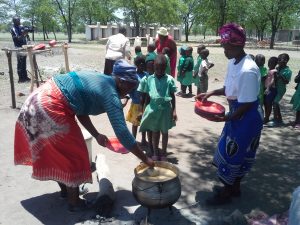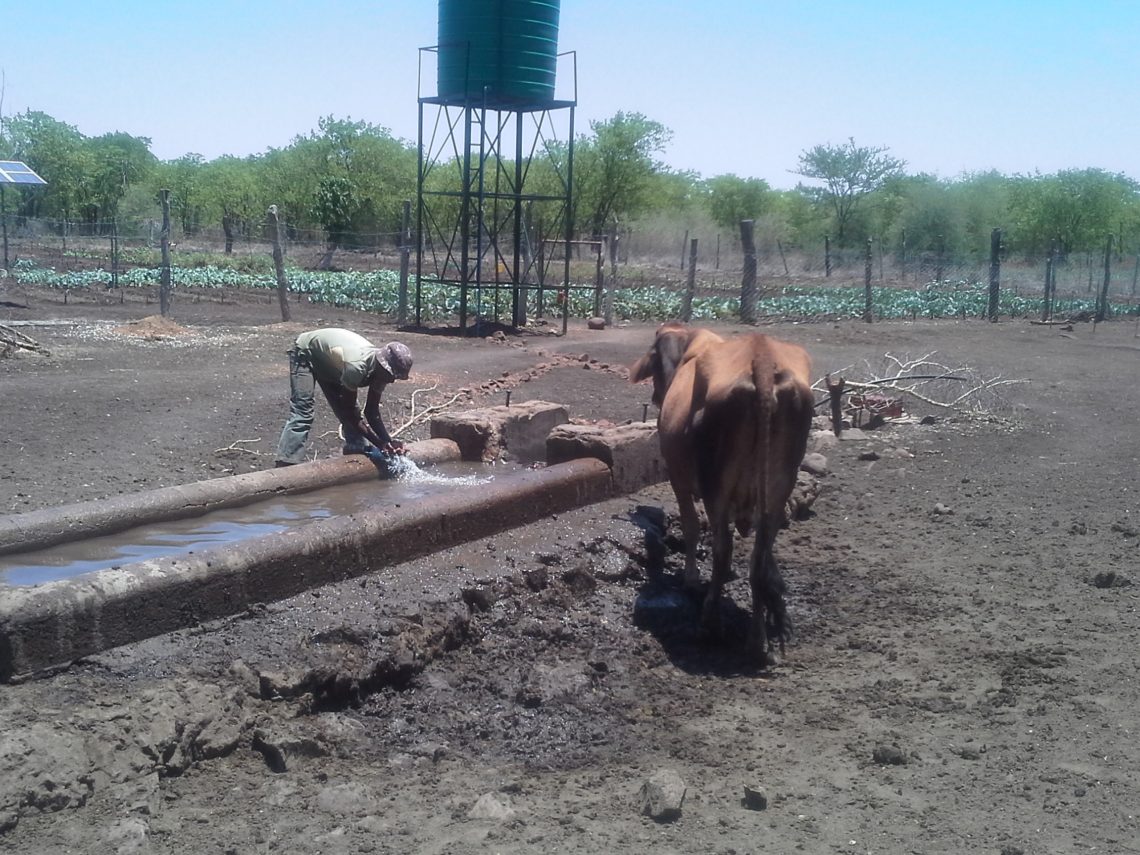By Byron Mutingwende
The drive through Hippo Valley Estates from Chiredzi Town heading towards the south is panoramic and breath-taking. There is a hive of activity as sugar-cane cutters are ferried by huge tractors to and from work. Huge piles of molasses bags are heaped at the Tongaat Hullet Sugar Refinery and in the fields burnt cane is scattered. The scene suddenly changes as one crosses Runder River to Chilonga, a dry place on the banks of the mighty river.
Goats bleat, cows are mooing and birds chirping in the scorching heat of the afternoon of Tuesday 6 December 2017. Despite being on the brinks of a river almost overflowing to its banks, vegetables in most homes’ nutritious gardens in Njiwonjiwo Village of Ward 7 in Chilonga area are almost wilting.
“Temperatures soar to over 40 degrees Celsius on many a summer day. Most villagers have wells and boreholes at their homesteads. It is just midday and as you can see, the ground is wet but the vegetables are wilting because of the scorching sun,” Peter Hlaneki, the Ward 7 Chairperson of the Food and Nutrition Committee of the Chilonga area who is an agricultural extension worker under the ministry of agriculture, mechanisation and irrigation development.
Hlaneki revealed that the past few years, save for 2016 which received more rainfall due to the La Nina effect, have been hit by intermittent droughts. The irony of it all is that the giant Chilonga Irrigation Scheme, previously a food security hub of the Lowveld region is now just but a shadow of its former self.
Tawanda Baramasimbe an official of the Agricultural Extension Services (Agritex) department of the ministry of agriculture said the Chilonga Irrigation Scheme, home to 315 famers with pieces of land ranging from 0,1 ha to 1ha each, has been facing water problems for close to nine years now.
“Climate change has dealt the community here a serious blow. Established in 1964, the Chilonga Irrigation Scheme was a food security hub. Ever since, farmers under the scheme have been doing a great job of producing food for the Southern region stretching from Bulawayo and the Matebeleland provinces, parts of Chipinge South area, Chiredzi down to Chikombedzi near Gonarezhou Game park.
“They rotated crops like wheat, beans, tomatoes, carrots, maize, sweet potatoes and cabbages to mention just a few. The farmers produced enough to feed themselves and a surplus for sale to other communities,” Baramasimbe said.
Phineas Muguva, the Committee Member of the Chilonga Irrigation Scheme blamed climate change for affecting the viability of the project.
“The heavy rains of 2016 and the resultant flooding resulted in massive land degradation whereby huge amounts of soil were washed away, leaving huge dongas that are not only dangerous to human beings but animals as well. It also resulted in massive siltation that changed the Runde River course, leaving the massive 15m deep pump that pumped water to the irrigation scheme dysfunctional since the water is now far away. While in the past few years we were complaining about droughts and less water in the river, the situation became severe last year when the massive siltation left the pump as a mere white elephant that can’t even pump a few drops of water to the irrigation canals. The communities are facing hunger in the eye yet large volumes of water are flowing to the sea despite the availability of the irrigation infrastructure,” Muguva said.
Organisations like Plan International, Hippo Valley Estates and Chiredzi Rural District Council are helping with support to reclaim the gullies and rehabilitate the derelict irrigation scheme. However, the rehabilitation requires a huge financial capital support from the government, civil society organisations and development partners.
Gift Machukele, the Principal Administration Officer of Chiredzi District said the derelict irrigation scheme had led to a plethora of problems, chief among them perennial food shortages.
“As the irrigation scheme became dysfunctional, the people of Chilonga are experiencing perennial food shortages. This has also affected local businesses resulting in many youths migrating to towns and cities. Vices like early child marriages and prostitution are on the rise,” Machukele said.
Isheunesu Matimbira, the Chiredzi District Nutritionist hailed food and nutrition security interventions by stakeholders for averting hunger and malnutrition in the area.
“The government, with support from stakeholders like the Cluster Agricultural Development Services, Plan International and GIZ is implementing drought mitigation strategies. It is promoting the growing of drought-resistant crops like sorghum and rapoko and encouraging people to practice conservation farming. Other people are also keeping fisheries and being capacitated on having nutrition gardens and orchards in pursuit of promoting the 4-star diet to promote nutrition,” Matimbira said.
Lizzie Nyashanu from Tonono Village is a member of the Rufaro Health Nutrition Club started in 2016. Using locally available resources, the club is practising nutrition-sensitive agriculture and is value adding its produce through use of home made solar driers. It also bakes bread and scones using home made ovens.
At Gwaseche Primary School, over 160 infants in early child development school are benefitting from a supply of porridge donated by the Malilangwe Trust. Egleen Dumela, the school head, said the school feeding programme was motivating children, particularly those from disadvantaged backgrounds to come to school, resulting in increased school enrolment.

“The infant departments have more enrolments compared to the upper grades because of the school feeding scheme. The food is given to infants in ECD up to Grade 2. Our appeal to stakeholders is to include upper grades as well since many children come from poverty-stricken families,” Dumela said.
